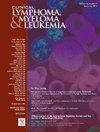使用低剂量抗胸腺细胞球蛋白进行hla错配造血干细胞移植后早期病毒和真菌感染的高危恶性血液病未缓解患者
IF 2.7
4区 医学
Q2 HEMATOLOGY
引用次数: 0
摘要
背景:抗胸腺细胞球蛋白(ATG)体内T细胞耗竭,尤其是高剂量ATG耗竭已被证明与异基因造血干细胞移植(HSCT)后感染发生率增加有关。然而,在高风险造血干细胞移植环境中,即使低剂量ATG是否会增加移植后感染的风险,目前仍不清楚:我们利用 82 例血液恶性肿瘤患者的数据,对移植后早期的病毒和真菌感染进行了单中心回顾性研究。其中,42 名患者接受了使用低剂量胸腺球蛋白(2.5 mg/kg n = 41,2.0 mg/kg n = 1)的 HLA 不匹配造血干细胞移植(ATG 患者),40 名对照组患者在同一时期接受了不含 ATG 的造血干细胞移植(非 ATG 患者)。脐带血移植患者除外。所有ATG患者在移植时都患有未缓解的血液恶性肿瘤,被认为是移植后感染的高危人群:结果:具有临床意义的巨细胞病毒感染(csCMVi)、停用利特莫韦后晚期CMV再激活、侵袭性真菌疾病或与爱泼斯坦-巴尔病毒(EBV)相关的移植后淋巴增生性疾病的发生率在组间无明显差异。ATG 和非 ATG 患者的 CMV 抗原血症峰值几乎相同。两组患者使用 Letermovir 预防 csCMVi 的效果相同。然而,与非 ATG 患者相比,ATG 患者的 CMV 再激活更早,EBV 病毒血症的发生率更高。在他们的基础疾病中,成熟T细胞肿瘤是CMV/EBV再激活的重要风险因素:结论:在HLA不匹配造血干细胞移植治疗非缓解期血液恶性肿瘤中使用小剂量胸腺球蛋白是一种合理的策略,但需仔细监测病毒再激活情况。本文章由计算机程序翻译,如有差异,请以英文原文为准。
Viral and Fungal Infections Early After HLA-Mismatched Hematopoietic Stem Cell Transplantation Using Low-Dose Antithymocyte Globulin in High-Risk Patients With Hematological Malignancies Not in Remission
Background
In vivo T-cell depletion with antithymocyte globulin (ATG), especially at high-doses has been shown to be associated with increased incidence of infections after allogeneic hematopoietic stem cell transplantation (HSCT). However, it remains unclear whether ATG, even at low-doses increases the risk of posttransplant infections in the high-risk HSCT setting.
Patients and Methods
We conducted a single-center retrospective study of viral and fungal infections early after transplantation, using the data from 82 patients with hematological malignancies. Among them, 42 underwent HLA-mismatched HSCT using low-dose (2.5 mg/kg n = 41, 2.0 mg/kg n = 1) thymoglobulin (ATG patients), and 40 control patients received HSCT without ATG (non-ATG patients) during the same period. Cord blood transplantation patients were excluded. All ATG patients had hematological malignancies not in remission at the time of transplantation, and were considered to be at high-risk for posttransplant infections.
Results
There were no appreciable between-group differences in the incidence of clinically significant cytomegalovirus infection (csCMVi), late-onset CMV reactivation after discontinuation of letermovir, invasive fungal diseases or Epstein-Barr virus (EBV)-associated posttransplant lymphoproliferative disease. Peak values of CMV antigenemia were almost equal in ATG and non-ATG patients. The prevention of csCMVi with letermovir was constant in the 2 groups. However, ATG patients showed earlier reactivation of CMV and higher incidence of EBV viremia than non-ATG patients. Among their underlying diseases, mature T-cell neoplasm was a significant risk factor for CMV/EBV reactivation.
Conclusion
The use of low-dose thymoglobulin in HLA-mismatched HSCT for nonremission hematological malignancies is a reasonable strategy under careful monitoring for viral reactivation.
求助全文
通过发布文献求助,成功后即可免费获取论文全文。
去求助
来源期刊

Clinical Lymphoma, Myeloma & Leukemia
ONCOLOGY-HEMATOLOGY
CiteScore
2.70
自引率
3.70%
发文量
1606
审稿时长
26 days
期刊介绍:
Clinical Lymphoma, Myeloma & Leukemia is a peer-reviewed monthly journal that publishes original articles describing various aspects of clinical and translational research of lymphoma, myeloma and leukemia. Clinical Lymphoma, Myeloma & Leukemia is devoted to articles on detection, diagnosis, prevention, and treatment of lymphoma, myeloma, leukemia and related disorders including macroglobulinemia, amyloidosis, and plasma-cell dyscrasias. The main emphasis is on recent scientific developments in all areas related to lymphoma, myeloma and leukemia. Specific areas of interest include clinical research and mechanistic approaches; drug sensitivity and resistance; gene and antisense therapy; pathology, markers, and prognostic indicators; chemoprevention strategies; multimodality therapy; and integration of various approaches.
 求助内容:
求助内容: 应助结果提醒方式:
应助结果提醒方式:


